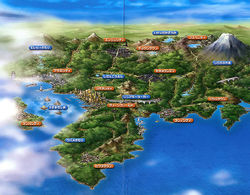Johto
The Johto region (Japanese: ジョウト地方 Jōto-chihō, Jouto is also seen) is a large area located west of Kanto. Together Johto and Kanto make up one large continent, with everything west of Indigo Plateau falling in the Johto region. First explored in Pokémon Gold, Silver and Crystal, it is home to an additional 100 Pokémon that were not present in previous games. The names of most of the cities in Johto are also the names of plants or things related to plants. In the Generation II games, players begin their journey in New Bark Town, where Professor Elm offers either Chikorita, Cyndaquil or Totodile to beginning Pokémon trainers.
Geography
The geography of Johto is much like that of Kanto. It is marked by a mountain range in the north.
Locations
Cities/Towns
- New Bark Town
- Azalea Town
- Cherrygrove City
- Violet City
- Goldenrod City
- Ecruteak City
- Olivine City
- Mahogany Town
- Blackthorn City
- Cianwood City
Areas of interest
- Ruins of Alph
- Tin Tower
- Sprout Tower
- Slowpoke Well
- Union Cave
- Ilex Forest
- Radio Tower
- Dark Cave
- Whirl Islands
- Tohjo Falls
- Mt. Silver
- Indigo Plateau
- National Park
- Mt. Mortar
- Battle Tower (Crystal only)
League
Main article: Johto League
The Johto League is the regional Pokémon League of the Johto region. Johto and Kanto share a single Elite Four, located on Indigo Plateau. Eight Johto League Badges are required to participate in League competitions.
Gym Leaders
The following is a list of Gym Leaders in the Johto League:
Culture
History
Connection to Japan
Main article: Pokémon world in relation to the real world
Regardless of their proximity, the people of Johto and those of Kanto are set apart by many cultural differences. Johto is based on the real Kansai region in Japan. This trait is most noticeable in its geography; however, the Kansai influence also defines the culture in Johto. Kansai residents are known for their attitudes against typical Japanese standards, mostly due to the historical rivalry between the region, once the major seat of political power, and the real Kantō region where Tokyo, the current capital, is located. The soil of the Kansai region is rich, unlike the volcanic Kantō region. People from Kansai are considered to be more relaxed. Kansai and Kantō, however different, are the two most important areas of Honshū, the largest island in Japan, and, much like Johto and Kanto, represent a harmony of contrasting cultures living together. The cultural divide is most noticeable in the games, as the player talks to and learns about the citizens of both regions.
Certain cultural aspects of the Johto region are deep-seated in Japanese history, aswell. Kyoto, which is probably the basis for Ecruteak City, is considered the cultural center of Japan. Kyoto and its many historical temples, shrines, palaces, gardens and architecture have been preserved. This connection to history is reflected in many areas of Johto. However, Goldenrod City (like Osaka) is typically modern.


